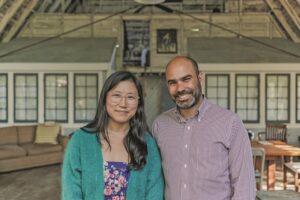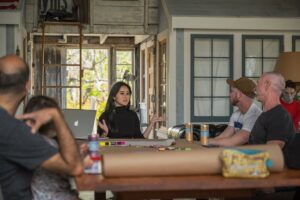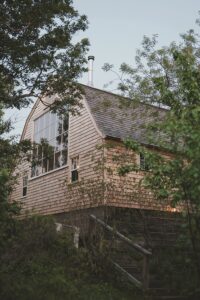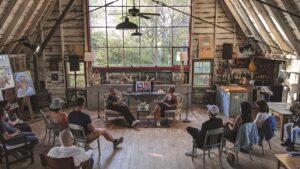The tenth season of Twenty Summers, a program of artist residencies and cultural events held in the Hawthorne Barn in Provincetown, begins this month. The barn’s history informs the organization’s connection to the town’s past and its ambitions for the future.

“In my mind, Twenty Summers is synonymous with the barn itself,” says Joshua Prager, one of the founders of the organization and its director emeritus.
The airy, light-filled barn on Miller Hill Road was built atop a sandy bluff by artist Charles Hawthorne in 1907. It became the home of the Cape Cod School of Art, where Hawthorne, Hans Hofmann, and Henry Hensche led classes. “It looms large in the history of arts and letters in America as a birthplace of the American avant garde,” says Twenty Summers Executive Director Aziz Isham. Lee Krasner, Jackson Pollock, Tennessee Williams, Norman Mailer, and Norman Rockwell are among the artists and writers who studied or spent time in the barn.
“If the Provincetown artists’ colony can be said to have a birthplace — that is, something more structural than the dunes and tidal flats and Cape light — this is the place,” writes David W. Dunlap in Building Provincetown.
In the spirit of the barn’s history, Twenty Summers describes itself as “an incubator for art and ideas.” But, per its name, it also has forward-looking ambitions, imagining “a more equitable and sustainable future, twenty summers from today.”
Seven resident artists will inhabit the barn this month to create work and share ideas. “We curate for groups,” says Isham. “We really try to mix it up and bring different people together.” The result doesn’t look like your grandfather’s art school. The residents at Twenty Summers, chosen by a nominating committee, expand on the types of people and art that filled the barn a century ago.

“I firmly believe Twenty Summers needs to be part of a movement to decolonize art spaces,” says Isham. “Colonialism limited the ways that we interact with each other and culture in general. It created one vision of culture. We don’t want to get in a situation where we say that all art that has a colonialist parentage is bad, but we want to make sure the history of the barn is not limited to celebrating the greatness of midcentury white men.”
Consequently, diversity is at the core of the programming. This year’s cohort includes a queer Cantonese immigrant, a Zen Buddhist priest, a Vietnamese-Italian-American songwriter, and immigrants from Jamaica and Peru.
Twenty Summers’s conception of what constitutes art is equally diverse. While painting and drawing dominated the early history of the barn, today’s residents represent an expansive range of 21st-century artistic practice. Residents this year also include Jon Kung, a self-taught Third Culture cook and social media personality from Detroit, and Kate Rich, a “trade artist and feral economist.”

“We should be looking at other forms of art and lineages of art and try to emphasize the value we may have overlooked in the past,” says Isham. For him, the issue is personal. His grandmother Monir Shahroudy Farmanfarmaian (1922-2019) was an artist who was overlooked for most of her life. Born in Iran, she moved to New York in the late 1940s and worked as an illustrator while creating her own artwork and becoming acquainted with some of the art world’s biggest names, including Milton Avery, Frank Stella, and Andy Warhol. She eventually moved back to Iran, where she died. Farmanfarmaian achieved recognition in her home country for her dizzyingly complex cut-glass mosaics that combined elements of Western abstraction and Islamic patterning.
In the U.S., Isham says, “her work was seen as decorative or ornamental or secondary partially because she was a woman from Iran.” That changed in the 1980s, when her work was recognized by an influential curator. Since then, it has been shown at the Guggenheim Museum and the Museum of Modern Art. Her reputation continued to grow in Iran, where a museum dedicated to her artwork opened in 2017.
Bz Zhang is an artist from “so-called Los Angeles” or unceded Tongva land. “I felt extremely recognized,” Zhang says about the experience of being a Twenty Summers resident last year. Like all residents, Zhang received a daily stipend of $500. “We realized early on that if we want to invite artists from historically excluded backgrounds, we needed to address barriers to entry,” says Isham. “Housing and cost of living were the two big ones.”
“It was completely open,” says Zhang. “It was disarming to just have to exist and be here and see what happens. There were so many synchronicities and new connections happening in my brain that wouldn’t have happened in a more structured environment.”
Zhang explored topics related to migration, oil production, and queer history and shared the barn with Yásnaya Elena Aguilar Gil, an indigenous linguist who led Zhang to research the Chinese diaspora in Mexico. This type of cross-pollination is a core intention of the residency. (An exhibition last year at the Essex Art Center in Lawrence grew out of another Twenty Summers collaboration: Jeffery Mansfield, a deaf architect and 2021 resident, collaborated with fellow resident Raymond Antrobus, a deaf poet, for an installation about deaf spaces.)

Zhang found Provincetown an intriguing place to imagine the future. “As a queer person, I was thinking a lot about Provincetown as a refuge for queer people and queer communities,” says Zhang. “It has this history I treasure.” Zhang, who was an undergraduate at Brown, also mentions that Provincetown seemed like a place that “was more accessible to an older, whiter, more affluent group.” But Zhang is optimistic about what lies ahead: “Twenty Summers is pushing against a false binary of being future-oriented or past-orientated. They’re holding the past and the future at once — and moving forward.”
“Provincetown is nothing if it’s not an incubator of art and diversity,” says Prager, the author of The Family Roe (2021), the Pulitzer Prize nominated narrative of abortion in America. He’s currently working on a new book project exploring the Native American community through four generations of a South Dakota family.
As a child, Prager visited the Cape every summer with his family, who rented a house in Truro. “Provincetown was the spice that made our vacations exciting,” he says. “I grew up in a homogeneous world in the suburbs of New Jersey. Provincetown broadened our horizons.”

When Prager saw Hawthorne’s barn for sale for $550,000 in 2009, he cobbled together a down payment. He dreamed of preserving the barn as a space that nurtured creativity and community. When he realized the renovations were too costly, he made an agreement to sell the barn to Daniel Kaizer and Adam Moss, who would renovate the space and allow his fledgling organization — Twenty Summers — to use the barn for one month each spring. Twenty Summers’s first program was launched in 2014.
Unlike Isham, Prager doesn’t associate the barn with colonization. “I never thought about the barn in that way,” he says. “I don’t think it was only white men. There were certainly white women. I think it was diverse in its own ways as far as being a safe haven for gay artists and writers.
“Diversity is many things,” Prager adds. “I don’t see what we’re doing now as a shucking off of its past but an evolution. I’m thrilled to be a part of that.”
For information about this year’s residents and programs see 20summers.org.



